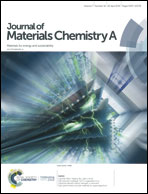Improved photovoltaic performance of a nonfullerene acceptor based on a benzo[b]thiophene fused end group with extended π-conjugation†
Abstract
A new indacenodithiophene-based acceptor–donor–acceptor (A–D–A) type nonfullerene acceptor material ITBTC, featuring a conjugation-extended benzo[b]thiophene-fused end group, was designed and synthesized. Compared to the well known phenyl-fused ITIC acceptor containing a 2-(3-oxo-2,3-dihydroinden-1-ylidene)malononitrile (IC) end group, incorporation of an additional electron-rich thiophene into the IC moiety decreased the electron-accepting strength of the end group and increased the intermolecular interactions of ITBTC molecules. As a result, ITBTC exhibited an elevated lowest unoccupied molecular orbital, an improved electron mobility, and a more favorable blend film morphology. Despite its slightly blue-shifted absorption, the photocurrent of ITBTC-based devices was well-maintained due to the extra absorption band in the short wavelength range, which is induced by its conjugation-extended end group. Benefitting from these characteristics, the ITBTC-based solar cells achieved an enhanced power conversion efficiency (PCE) of 10.99% with a simultaneously improved open-circuit voltage (Voc, 0.94 V) and fill factor (FF, 71.3%) and well-maintained short-circuit current density (Jsc, 16.37 mA cm−2), compared to those of the ITIC-based devices (PCE of 9.53%). These results suggest that extending the π-conjugation of end group through thiophene incorporation is an efficient approach for optimizing both the energy level alignment and intermolecular interaction of the acceptor materials while maintaining their efficient light-harvesting ability. Our study also demonstrates the great potential of the new benzo[b]thiophene-fused end group for constructing high-performance nonfullerene acceptors and provided insight into overcoming the trade-off between Jsc and Voc to realize simultaneously enhanced photovoltaic parameters.
![Graphical abstract: Improved photovoltaic performance of a nonfullerene acceptor based on a benzo[b]thiophene fused end group with extended π-conjugation](/en/Image/Get?imageInfo.ImageType=GA&imageInfo.ImageIdentifier.ManuscriptID=C9TA01111K&imageInfo.ImageIdentifier.Year=2019)


 Please wait while we load your content...
Please wait while we load your content...